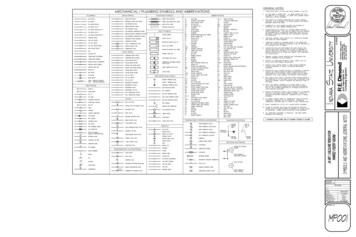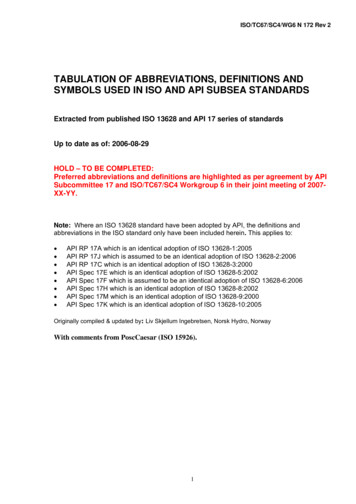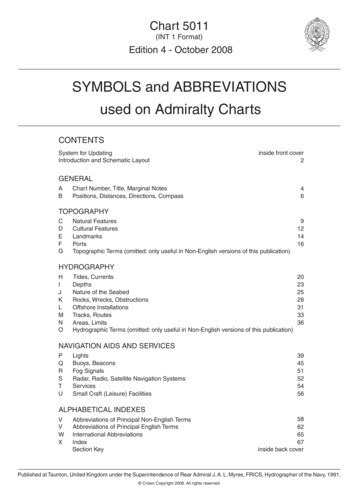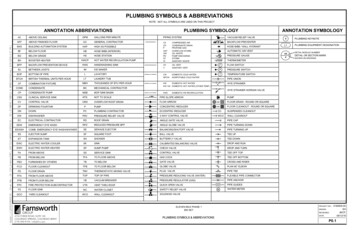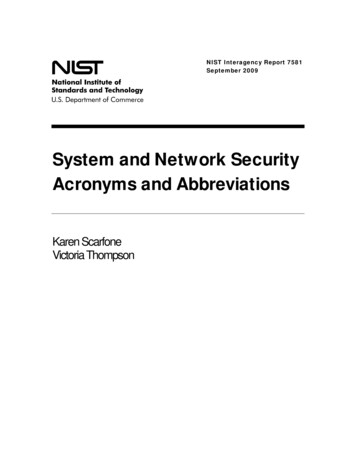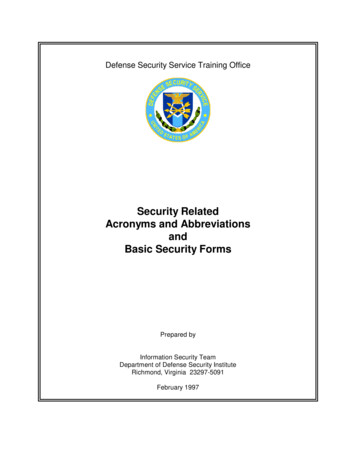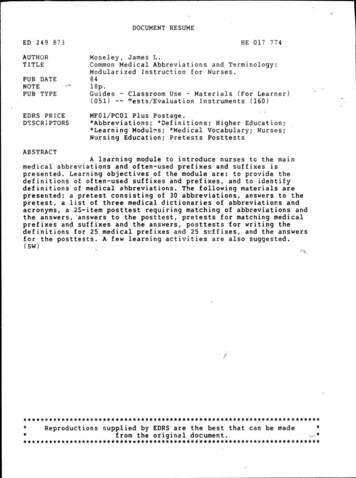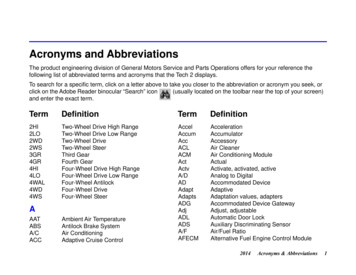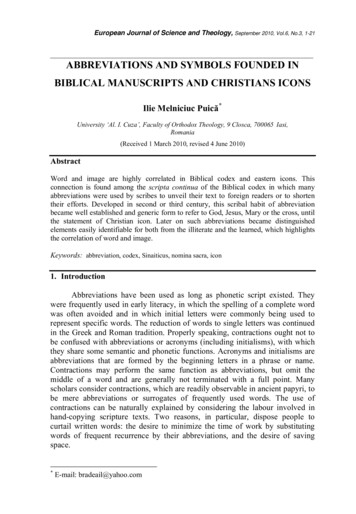
Transcription
European Journal of Science and Theology, September 2010, Vol.6, No.3, 1-21ABBREVIATIONS AND SYMBOLS FOUNDED INBIBLICAL MANUSCRIPTS AND CHRISTIANS ICONSIlie Melniciuc Puică *University ‘Al. I. Cuza’, Faculty of Orthodox Theology, 9 Closca, 700065 Iasi,Romania(Received 1 March 2010, revised 4 June 2010)AbstractWord and image are highly correlated in Biblical codex and eastern icons. Thisconnection is found among the scripta continua of the Biblical codex in which manyabbreviations were used by scribes to unveil their text to foreign readers or to shortentheir efforts. Developed in second or third century, this scribal habit of abbreviationbecame well established and generic form to refer to God, Jesus, Mary or the cross, untilthe statement of Christian icon. Later on such abbreviations became distinguishedelements easily identifiable for both from the illiterate and the learned, which highlightsthe correlation of word and image.Keywords: abbreviation, codex, Sinaiticus, nomina sacra, icon1. IntroductionAbbreviations have been used as long as phonetic script existed. Theywere frequently used in early literacy, in which the spelling of a complete wordwas often avoided and in which initial letters were commonly being used torepresent specific words. The reduction of words to single letters was continuedin the Greek and Roman tradition. Properly speaking, contractions ought not tobe confused with abbreviations or acronyms (including initialisms), with whichthey share some semantic and phonetic functions. Acronyms and initialisms areabbreviations that are formed by the beginning letters in a phrase or name.Contractions may perform the same function as abbreviations, but omit themiddle of a word and are generally not terminated with a full point. Manyscholars consider contractions, which are readily observable in ancient papyri, tobe mere abbreviations or surrogates of frequently used words. The use ofcontractions can be naturally explained by considering the labour involved inhand-copying scripture texts. Two reasons, in particular, dispose people tocurtail written words: the desire to minimize the time of work by substitutingwords of frequent recurrence by their abbreviations, and the desire of savingspace.*E-mail: bradeail@yahoo.com
Melniciuc Puică/European Journal of Science and Theology 6 (2010), 3, 1-21Christian manuscripts, produced in private or in scriptoria, regularlyemployed dieresis, breathing marks, punctuation, paragraph markers, sectionmarkers and page numbering [1]. Paragraphoi mark text divisions in theChristian manuscripts P. Beatty 10 (Daniel and Esther), P. Bodmer 24 (Psalms),P. Freer of the Minor Prophets, and occasionally in tandem with vacant line endsin P. Beatty 6 (Numbers and Deuteronomy). The division in chapters andparagraphs in biblical manuscripts are marked by points followed by one ormore vacant spaces. The paragraphos was also used to mark the change ofpersons in a dialogue or the chorus parts in Greek literary texts [2]. The use ofdiaeresis or trema over I (iota) or Y (upsilon) was exceedingly rare until thesecond century, although it was not entirely unknown before then. Originallyintroduced as a means to distinguish a vowel which is to be pronouncedseparately from the vowel which follows it (and with which it would otherwisemake a diphthong), the usage was soon extended to vowels standing alone, and ittherefore became meaningless. In the earliest Biblical fragmentary materials (P52or Papyrus Rylands, dated somewhere in the second century), we notice theemergent use of the dieresis over an initial iota of a word following a word thatends in another vowel. In the same period, we also begin to see the use ofpunctuation and occasional breathing marks. It should also be noted thatpunctuation, in the form of the medial or high point (·), dicolon (:), diastole (,)and dash (–), can be seen as both lectional aid and text division marker.The written language that was used to compose manuscripts was not at allstandardized. The manuscripts we have from that period bear testimony of theamazing scribal fluidity both at the very early stages of the development of thesetexts as well as after their composition. Every scribe wrote in his own dialect,since there was nothing even close to a standardized Greek language yet. Onething however, was standardized in the manuscript era: the use of majuscules(capital letters) and minuscules (small letters). The contraction system was aChristian system, an innovation introduced by the Hellenistic Jews whotranslated from the Hebrew, particularly the authors of the Septuagint translationof the Old Testament. In the Greek manuscript tradition, it was a commonpractice to decorate the name of Jahveh with gold or purple letters. The primarymotive of presenting these words in a contracted form was a sense of reverence,as already explained, and not a desire of saving time or space, the usual reasonfor abbreviation and contraction. Occasionally, scribes did not reproduce a textexactly and freely omitted words and recasted the text in the interests ofconciseness, clarity and style. In this case, for liturgical use, correctors were todiscern the missing words and faults, thereby rendering an acceptable version ofthe original text.2. Nomina Sacra as abbreviationBiblical manuscripts can be considered as ‘public documents’, in thesense that they were intentionally produced to be read aloud by lectors atChristian gatherings. Christian monastic scriptoria in major centers maintained2
Abbreviations and symbols founded in biblical manuscripts and Christians iconsmaster copies of public gospel manuscripts. Although different copies of eachChristian text may have been held, consistency in the transmission of publicfeatures (text division, punctuation and lectional aids), production was controlledin Christian scriptoria. Indeed, separating the continuous lines of letters inancient texts (scriptio continua) in order to penetrate the underlying meaning,was not an easy task. In a public setting, where immediacy was called for, textdivision, punctuation and lectional aids could greatly assist the task of the lector(anagnostes) [3].The Christian monks developed a new system of reading, a system whichwas based upon the constant and central presence of a book of which thecontents were almost known by heart. In the monastic communities, however,reading the Scriptures had a purpose entirely different from that ordinarilyattributed to reading: namely, the transmission of knowledge. Despite thecentrality of the oral relationship between spiritual master and disciple, the newmonastic culture did not give up on the dimension of writing and reading, northat of listening to the book being read or recited [4]. The monk’s intellectualactivity was centered on reading the Scripture. The Christian adoption of silentreading seems to be directly linked to the practice of private reading of the Biblein monastic milieus during meditation and oration. Such practice permits theconception of an interior book, written not on parchment, but in the heart of thebeliever (2 Corinthians 3.3). The origin of silent reading among early Christianelites reflects the transformed status of the individual in the new religioussystem, and it must have been as closely related to it as the use of the codex was[5].The nomina sacra for Christ were: ku,rioj, qeo,j, Cristo,j, Ihsou/j andperhaps pneu/ma. The primary motive of presenting these words in a contractedform was a sense of reverence, as already explained, and not a desire of savingtime or space, the usual reasons for abbreviation and contraction. The earliestChristian writers used the nomina sacra in three ways. Firstly, suspension: thefirst two letters of the name are written and the rest are suspended. The second iscontraction: the first and last letters are written and the rest are omitted. Thethird is ‘complex’ contraction: the first and last letters are written as well assome other letters. Once the scribe wrote down the abbreviated form, a supralinear bar was placed above the name, which was a common scribal indicator,signifying that the letters below are abbreviated.2.1. Biblical background in Nomina SacraThe origin and development of the nomina sacra is much debated inscholarly circles and no agreement has been reached. Ludwig Traube, who firstcalled these contractions nomina sacra, thought that their origin was to be foundin the context of Hellenistic Jews’ need of a Greek equivalent for the HebrewTetragrammaton IHWH. In Greek the words are generic words, titles, while inHebrew the word was seen as a proper sacred name. The Greek words and theHebrew tetragrammaton are different classification of words. We found a3
Melniciuc Puică/European Journal of Science and Theology 6 (2010), 3, 1-21consistent use of Nomina Sacra forms for Ku,rioj (or qeo,j) restricted to each ofthe 42 quotations of Hebrew Scripture passages in Greek manuscripts ofChristian Scripture and of the tetragrammaton in a limited 237 instances withinthe Christian Scriptures. Schuyler Brown observes that it was ku,rioj and notqeo,j which was used to represent the tetragrammaton. He argued that the initialcontraction of ku,rioj was quickly extended in one direction to qeo,j and in theother direction to Ihsou/j and Cristo,j [6].The eastern form of Greek alphabet contained a special feature from letterS, named lunate sigma. This letter, used in medieval manuscripts, resembles theLatin letter C, and can still be found in Greek Orthodox inscriptions. The formof Cyrillic letter C (which are value of S) and Sima letter from Coptic alphabetare derived from lunate sigma. It was easily for scribes to use the symbol C andnot Σ, thinking that he must wrote fast and carefulness. This letter also replacedthe intermediate and final S, which had special forms in the Western Greekalphabet.Ku,rioj is a title and common attribute of Jesus in Paul (the name Jesus ismore current). Already in the Septuagint, the term was used to maketetragrammaton divine. In Philippians 2.11 ‘name’ underline the dignity ofChrist. Ku,rioj is an attribute that belongs to ‘cheering’ and the name of Jesusexpresses a dignity which causes adoration and confession of his sovereignty.The name given to the envoy God at the resurrection is not ‘Lord’ or ‘Jesus’, butan ineffable name. Outside the tetragrammaton that somehow the seal, themystery of God’s name is not highlighted, while the unfathomable mystery ofGod himself is often proclaimed. Jesus is open to men and it reveals what isimportant for them, the dimensions of love and holiness of God and hiswillingness hello. He wears the names whose meaning is given or entered atradition Jesus explained in Matthew 1.21: “he will save his people from theirsins”, “Emmanuel”, Matthew 1.23, “God with us”. ‘Christ’ is a well knownconcept in Judaism. ‘The Son’ shows at least a unique relationship with God theFather. It still has the name “Son of Man” by which is sometimes referred toJesus as the Gospels and refers apparently it at a figure of the apocalyptictradition (cf. Daniel 7.13). Finally, Jesus is called ‘Lord’ in 1 Corinthians 8.6:“yet for us there is one God, the Father, from whom are all things and for whomwe exist, and one Lord, Jesus Christ, through whom are all things and throughwhom we exist”. The shared title between God and Christ is one of thearguments of those who are convinced that the mysterious name of Philippians2.9 can only be ‘Lord’.If the confession Ku,rioj Ihsou/j Cristo,j becomes a necessity, at final offirst century appears the necessity to confess cryptically the divine sovereignty.The second text, Revelation 19.11-16, says: “And I saw heaven opened,and behold a white horse; and he that sat upon him was called faithful and true,and with justice doth he judge and fight. And his eyes were as a flame of fire,and on his head were many diadems, and he had a name written, which no manknoweth but himself. And he was clothed with a garment sprinkled with blood;and his name is called, THE WORD OF GOD. And the armies that are in heaven4
Abbreviations and symbols founded in biblical manuscripts and Christians iconsfollowed him on white horses, clothed in fine linen, white and clean. And out ofhis mouth proceedeth a sharp two edged sword; that with it he may strike thenations. And he shall rule them with a rod of iron; and he treadeth the winepressof the fierceness of the wrath of God the Almighty. And he hath on his garment,and on his thigh written: KING OF KINGS, AND LORD OF LORDS.” In v. 11He was named “Faithful and True”, in v. 13 a remarkable name is given to Him,“the Word of God” and in v. 16, it has a title particularly heavy, “King of kingsand Lord of lords.” The critical confession was necessary during the persecutiontimes. Perhaps, if in future will be discovered other old Christians texts, thissupposition will be demonstrated. Because the oldest texts which contain nominasacra stems from the second century, we don’t know if these abbreviationsresulted from cryptical needs or from scribal habits only.2.2. Abbreviations in Papyrus with biblical textPapyrus Bodmer II (P66), from 200 A.D. contains John 1.1-6.11; 6.3514.26, 29-30; 15.2-26; 16.2-4, 6-7; 16.10-20.20, 22-23; 20.25-21.9, 12.17. Bothrecto and verso are paginated in the standard form for post-Hellenistic codices,beginning with Alpha and ending with Omega. The handwriting of the originalscribe is characterized by Comfort as being “a practiced calligraphic hand”(381). The letters are written in majuscule (uncial) fashion, with an overt attemptat making them large, which suggests that the text was meant to be read aloud.Such abbreviated nomina sacra in P66 include qeo,j, ku,rioj, Ihsou/j, Cristo,j,pneu/ma, a;nqrwpoj (Figure 1). We can compare P66 with P75 in order to observethe evolution of abreviation for the word a;nqrwpoj (Figure 2).Papyrus Egerton 2 consists of fragments of three leaves of a codex.Written in the end of the second century AD, the ‘Unknown Gospel’ – popularname attributed on this papyrus - is an oldest biblical document. On both pagesof each of these leaves there is one column of text. Only two of them (fragment1: 11.5 9.2 cm; fragment 2: 11.8 9.7 cm), however, offers a partially coherentpiece of text. The third one contains just a few words – it is simply too small toreconstruct this text (6 2.3 cm).Papyrus Egerton 2 is interesting, not only for its text but also for itspaleography, because the fragments indicate that from very early on, Christiansseem to have used the codex for their writings instead of the scroll. In thispapyrus we have one of the earliest extant witnesses for the Christian practice ofusing so-called nomina Sacra, i.e. shortened forms of important holy names suchas “God”, “Lord”, “Jesus” and “Christ” [7, 8]. Papyrus Egerton 2, however, notonly contains the most common forms of nomina Sacra, but also shortenedforms of words such as “Father”, “Moses”, “Isaiah” and “Prophets”[9]. Thisapostrophe (high comma) was frequently used during the third century, but notduring the second.5
Melniciuc Puică/European Journal of Science and Theology 6 (2010), 3, 1-21Figure 1. Papyrus Bodmer II (P66), 200 A.D., John 1.8-13(http://www.earlham.edu/ seidti/iam/tc pap66.html).Figure 2. Papyrus Bodmer XV (P75), 175-225 A.D., Luke 24.53 – John 1.1-8(http://www.earlham.edu/ seidti/iam/tc pap75.html).P6
Abbreviations and symbols founded in biblical manuscripts and Christians iconsAnother biblical manuscript is Papyrus Lond.Lit.207, a piece from thirdcentury, preserved in the British Museum of London. This piece, from the OldTestament text, contains Psalms 11.7 to 14.4. In this manuscript, we find onlytwo nomina sacra (Table 1). In his study Don Barker suggested the possibilitythat Kύριος was first abbreviated word and only later θεός, which indicates anevolution of the scribal habit [10].Table 1. Samples of abbreviations from nomina sacra in Papyrus Egerton 2 andP. Lond.Lit.207 (http://www-user.uni-bremen.de/ �σουςMosesMosesΜωϋσηςEgerton 2Lond. Lit. 207------2.3. Abbreviations in biblical codexOnly nine of the sixty biblical manuscripts yet discovered contain parts ofNew Testament which were written before the eleventh century. After thiscentury the biblical manuscripts are written in small caps, with accents andpunctuation. The most known are Codex Sinaiticus, Codex Vaticanus and CodexAlexandrinus (Figures 3 and 4).7
Melniciuc Puică/European Journal of Science and Theology 6 (2010), 3, 1-21The Codex Sinaiticus dates back to the middle of the fourth century whenConstantine the Great commissioned about 50 copies of the Holy Bible. It waspossibly produced in one of the big cities of the Mediterranean Sea, perhaps inAlexandria or Caesarea in Palestine.Codex Sinaiticus ( א or 01 Gregory) originally contained approximately730 vellum leaves in a single bookbinding. One sheet in this codex consists oftwo conjugate leaves which meet at the fold, thus producing four pages.Konstantin Tischendorf has found this codex in the Saint Catherine Monasteryof Mount Sinai in the middle of the nineteenth century.Figure 3. Codex Vaticanus (B or 03 Gregory), 4th century AD, Luke 24.44 - John 1.14(http://www.earlham.edu/ seidti/iam/tc codexv.html)Legend: red - nomina sacra; blue - nomina sacra without abbreviation.8
Abbreviations and symbols founded in biblical manuscripts and Christians iconsFigure 4. Codex Sinaiticus ( א or 01 Gregory), 4th century AD, Luke 1.25-56(http://images.csntm.org/Manuscripts/GA 01/GA01 029b.jpg x?dir next&folioNo 5&lid en&quireNo 77&side r&zoomSlider 0).9
Melniciuc Puică/European Journal of Science and Theology 6 (2010), 3, 1-21In May 1844 he found 129 parchment sheets in a basket in the library ofthe monastery and these were later published under the name of ‘CodexFrederico-Augustanus’ to signify the patronage of the king of Saxony. After asecond trip to the monastery in 1853, he was informed in February 1859 by themonastery’s librarian that a larger parchment manuscript containing 86 folioswas founded [11]. This section contains parts of the Old Testament, the folios ofthe whole New Testament, the epistle of Barnabas and a part of the Pastor ofHermas.The surviving ca. 400 leaves were written on exquisite animal skins.Ancient craftsmen were able to fabricate codex sheets with dimensions of atleast 33.6 x 54.4 cm. Each leaves of Codex Sinaiticus measured approximately36 x 33 cm; and each leaf contained 4 columns per page (or eight columns to anopening), with a regular pattern of 48 lines per column. Parts of the CodexSinaiticus are stored today in four different places: 12 fragmentary leaves and 14small fragments remained in Saint Catherine Monastery; 43 leaves are kept inLeipzig University Library since 1844; and a part of five folios are found in TheNational Library of Russia from Petersburg. The British Library of Londonpossesses 347 leaves of the Codex, which contains the complete New Testamentand parts of the Old Testament. This codex represents the most accurate variantof Byzantine text.Milne and Skeat argued that two of three scribes interacted very closely,scribe A, who almost copied the entire New Testament and corrected his ownwork, and scribe C, who corrected the work of scribe A and contributed to anumber of corrections to scribe A’s work (Mark 14.54–16.8, Luke 1.1–56 orHebrews 4.16–8.1) [13].L. Hurtado has argued that Ihsou/j may have been the first of the nominasacra and that its origin lay in the Christians’ special reverence for the name ofJesus [7]. Trobisch’ argument is that the autographs of the New Testament werewritten with the tetragrammaton in place. A later editor then changed theHebrew letters to ku,rioj. A still later editor copied this original nomen sacrumand introduced other divine names in the final edition [14]. These copies wereused as exemplars for further copies and those copies would also be copied,producing entire textual families containing nomina sacra. The contention thatthe nomina sacra practice began under the influence of the Jewish practice ofwriting the tetragrammaton seems to be the most likely view that have beenintroduced to account for their origin. Whether or not this first occurred incopying the Old Testament into Greek or in the testimonia [15], these textswould have influenced the Pauline community. Testimonia especially seem alikely candidate for the origin of the nomina sacra, in that these texts werecollections of Old Testament prophecies that were used to prove the messiahshipof Jesus. These prophecies would have contained the tetragrammaton, whichwould then be rendered as ku,rioj as the texts were translated to Greek.10
Abbreviations and symbols founded in biblical manuscripts and Christians iconsThe horizontal supra-linear bar written by the first hand to mark a nomensacrum is formed by drawing a near horizontal line which begins and ends witha serif. The serif is either sub-linear or at level with the bar. In a culture in whichtexts were written without spaces (scriptio continua), the superscript line wouldstand out as a marker. Not only would this marker set aside these words asspecial (sacred), but also would ease in the reading of the text. The scribesmarked these words as special words, reflecting the worship of Jesus, God andthe Spirit in early Christianity. The practice of employing nomina sacra for allthree members of the Godhead demonstrates a Trinitarian belief system in theearly Church.2.4. Letters transformed in symbolsIn the nomina sacra we also witness the interaction of the early literaryculture of Christianity with the early visual culture of Christianity. In theseabbreviations we notice not only scribal reverence, but also a move towardsvisually representing this reverence. As Hurtado notes: “The aim is clearly: toexpress religious reverence, to set apart these words visually in the way they arewritten. The beautifully drawn and written manuscripts had an impact on howthe relatively new Christian church was perceived in World. This was mainlybecause old, traditional ornaments or images were incorporated into themanuscripts, thus making people feel they already knew some things about theGospel. In the nomina sacra, we encounter a fascinating manifestation of ancientChristian devotion, and these scribal symbols are perhaps the earliest survivingartefacts of an emerging Christian material culture.” [7]Echoing an observation by Erich Dinkler several decades ago, I haveemphasized that the nomina sacra are to be taken as textual/scribal phenomenawith an ‘iconographic’ significance [16]. In this way, they form perhaps ourearliest extant expressions of an emergent Christian ‘visual culture’ and shouldbe taken into account charting the emergence of early Christian efforts toexpress their faith visually. Perhaps the nomina sacra should be included in ourefforts to explore the origins of Christian art and iconography. To quote Hurtadoonce again: “The use of the nomina sacra in Christian manuscripts functioned tosignal any equivalent action by readers. So far as we can tell, lectors of theseearly Christian manuscripts pronounced fully and explicitly the words written asnomina sacra, including the key words for God and Jesus. This is why,therefore, I emphasize that the nomina sacra registered solely as visualphenomena and could be experienced solely by those who read (or otherwiseviewed?) the manuscripts in which they were written”[17].In the Christian church the traditional battle has been waged betweenliteral interpretation of the fundamental doctrines of the Bible and the ancientliving Bible version that is more open to a personal connection to metaphor andmytho-poetic aspects of the imagery [18]. In recent decades the Christian worldseems to have been ‘taken over’ by a resurgence of Christian churches that basetheir philosophies and life on an absolutely literal interpretation of the stories11
Melniciuc Puică/European Journal of Science and Theology 6 (2010), 3, 1-21and images in the Bible. As Spong notes, “The very abstractions of theologicallanguage can be so difficult as to be emotionally draining. But this also meansthat these very much literalized symbols will inevitably have to die in thepassage of time. The only way to keep symbols alive forever is to crack themopen periodically so that they can be filled with new meanings. No symbol canever remain as a timeless truth, inerrant or infallible.” [19] The symbols of ourfaith are always literalized. Time moves on and knowledge expands until theliteralized symbols begin to break down. The iconoclastic controversies betweenthe supporters and opponents of images that have periodically erupted in Jewish,Christian, and Muslim history have generally resulted in replacing one set ofimages with another, and this case is no exception.2.4.1. MonogramsThe monogram is a combination of two (or, sometimes, more) letters,which refer to the name of a person or to a title. This abbreviation is also called‘ligature’ or ‘compendia’.(a)(b)Figure 5. Christograms: (a) on reverse coin dating from emperor roman Constantine theGreat (306-336 A.D.); (b) in Catacomb of St. Sebastian, gi?template submagnify&id 1779&table items).The combination between che (X) and rho (P) from the non-biblicalGreek manuscripts expressed either the name of ‘centurion’ (e katonta,rchj) orcommander (cili,arcoj), or the adjective ‘good’ (crhsto,j) [20]. For example,che-rho, (using the first two letters of the name Crhsto,j), made direct referenceto ‘Christ’ (Figure 5). When a manuscript used the iota-eta (IH), combination,the first two letters of the name Ihsou/j with a continuous line over them, wasseen by the reader to represent the monogram of the first Christians. We should12
Abbreviations and symbols founded in biblical manuscripts and Christians iconsalso mention that the iota-che combination was mainly acknowledged as acombination of the initial letters from Ihsou/j Crhsto,j. The Christogram (XP),becomes at the end of Constantine the Great’s reign (306-336 A.D.) a Christiansymbol, as the ruler put the celestial sign, which appeared at Pons Milvius, onthe flags (labarum) and shields of his fighters [21, 22]. Probably during thisperiod the Christogram converted into stavrogram (the X was turned to fix twosides vertically and two sides horizontally, and the vertical top side wasextended through the letter rho (P).(a)(b)Figure 6. Staurograms: (a) the sign; (b) in P. Bodmer II (P66), Geneve, transliterate.(a)(b)Figure 7. Christograms: (a) flanked by Alfa and Omega in St. Callist Catacombs, tacombs.htm); (b) on the sarcophagusof Domatilla, Rome, middle of 4th e/ECArchOne.html).13
Melniciuc Puică/European Journal of Science and Theology 6 (2010), 3, 1-21The tau-rho combination is also found in pre-Christian documents, asabbreviation for tro,poj (place), or tria,kaj (thirteen). Through examples worthyof being highlighted, we should mention the use of this combination on somecoins of King Herod’s (37-4 BCE), for identifying his thirteenth year of rule.Table 2. Nomina sacra abbreviations deciphering in B. Metzger [12] search. See inFigure 4 the abbreviations colored from each name in Luke 1.25-56.No.123456789101112131415English ry)FatherIsraelSaviorManJerusalemHeavenGreek YThe overlap of rho on tau may be conceived as a stylized head of acrucified man (Figure 6). The first abbreviations for stauro,j and stauro,w (eachtime with overline for abbreviation) such as ‘nomina sacra’ can be found inPapyrus Bodmer II (P66), ten occurrences are found in the Gospel according toJohn (19.6, 10, 15, 16, 17, 19, 25, 31), where both the noun and the verbal formsare abridged. Especially from the Epistle of Barnabas (12.8), we know that theGreek grapheme tau was used by Christians as visual reference to Jesus Christ’sCrucifixion [23].14
Abbreviations and symbols founded in biblical manuscripts and Christians iconsThe combination of the letters tau-rho becomes rather a visualphenomenon, which was meant probably, just like many researchers suggested,being an early pictographic representation of Jesus crucified (Figure 7). Amongother conclusions, L.W. Hurtado states that tau-rho heralds the che-rhocombination from the Christ symbolism of early Christians, naming it “the firstperceptible Christian icon” [17, p. 141].Nomina Sacra does not represent a phenomenon specific to the Greeklanguage, it also appears in the Latin, Coptic, Slavonic and Armenian languages.Nor are they merely found in manuscripts, they are also found in inscriptions,amulets and icons.Since the sixth century AD, most of the fifteen words treated as nominasacra were found in the biblical documents following the thorough studiesconducted by B. Metzger [12], P. Comfort and D. Barett [23, p. 199-254], andcurrently by L.W. Hurtado [24] (Table 2).2.4.2. SymbolsSymbols provide many ideas, more than the shape of a digit, of someplaces and decorations, exceeding the historical context. The other three layersof meaning that may be revealed in an icon are described under the meaning ofclothing: allegorical, anagogical, and tropological icons are ‘windows’, thereforemuch more than an ordinary drawing or representation.In Christian icons, we find around the head of Jesus some inscriptions orabbreviations. In the icon we see the ‘hallo’ or ‘aura’, namely a circle of lightaround the head of Christ - or of a holy
Abbreviations and symbols founded in biblical manuscripts and Christians icons 3 master copies of public gospel manuscripts. Although different copies of each Christian text may have been held, consistency in the transmission of public features (text division, punctuation and lectional


